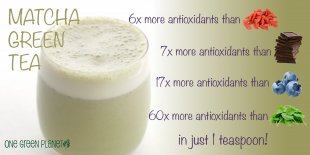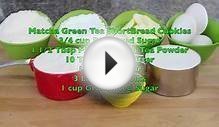
What is Matcha green Tea?
A hot cup of green tea with perhaps some warmed almond milk or lemon is sure to satisfy your soul and give you a gentle boost of caffeine. But beyond the realm of regular green tea, lies an incredible superfood known as matcha green tea. Perhaps you’ve heard of it, but if not, it’s time you met one of the most potent superfoods that exists, containing more nutrients than you could imagine.
What is Matcha?
Matcha (pronounced MA-cha), has been part of the Japanese culture since the 12th century and is one of the most prized beverages in Japan, even to this day. Matcha green tea differs from regular green tea due to the way the leaves are produced. All teas originate from the same plant known as Camellia sinensis, which is a shrub native to China. The shrub produces all types of leaves for tea, including white, green oolong, black, and pu-erh tea. Depending on the region and how they’re processed, these types of teas differ in their antioxidant content, along with their caffeine content and other nutritional properties.

How is Matcha Different Than Regular Green Tea?
Matcha is a type of tea that’s far less processed than regular green tea because the leaves are never heated and kept under shade to preserve the natural nutrients found in the leaves. Regular green tea goes through much more processing during production and is also left to dry in the sun, versus in the shade like matcha is. Matcha green tea is a bright, green powder that’s also stirred into warmed liquid instead of boiling and brewing methods used when making regular green tea. Since you’re consuming the leaves whole in a milder powder with matcha, you’re also taking in more nutrients than just throwing the leaves away in a tea bag or straining them out in a strainer as you would with regular tea.
How Does Matcha Taste?
Like all green tea, matcha has slightly grass notes, but with a much richer, almost buttery flavor. It’s especially tasty when blended with some non-dairy milk and stevia, along with a little vanilla extract.
Superfood Benefits of Matcha:
- Matcha green tea far outweighs even some of the most powerful superfoods we know of today. It contains over six times the antioxidants in goji berries, seven times the antioxidants in dark chocolate, 17 times more antioxidants than blueberries, and 60 times the antioxidants found in spinach. And that’s just in one teaspoon!
- Matcha contains 137 times more of the popular antioxidant known as EGCG found in regular green tea. EGCG is a part of the antioxidant family known as catechins, which have been linked to better heart health, a healthy metabolism, and improved aging.
- The beautiful bright green tea has even been found to, because the antioxidants in the tea are so high, they help fight off immune system invaders known as free radicals.
- Matcha is five times higher in chlorophyll than regular tea. Chlorophyll is the green pigment found in plants that can help give you clear skin, protect your blood and heart, and also help prevent joint inflammation.
- Matcha green tea has been found to raise the metabolism, provide a long stream of energy versus a crash you get with coffee, and possibly help with weight management. Of course matcha isn’t a replacement for an unhealthy diet, but it is a much smarter, holistic way to raise your metabolism and gain energy instead of chemical-filled energy drinks and diet pills.
- Matcha also lowers anxiety due to the high, raw amounts of L-theanine found in matcha. L-theanine is an amino acid that promotes a state of relaxation and is the reason regular green tea is thought of as a calming beverage.
- Matcha only contains 35 milligrams of caffeine per teaspoon, which is almost a third less than a cup of regular black coffee.
Sounds pretty amazing for a tea, right? That’s because matcha, like all plant-based foods, has unique properties that make it special in its own light. Remember that matcha isn’t a quick-fix magic pill to perfect health, but it sure beats out other teas and is a better, less-processed option your body will thank you for.
How to Enjoy Matcha Green Tea:
Traditional use: Matcha can be enjoyed the same way you would use regular green tea, you just have to brew it a bit differently. Boil a cup and a half of water, pour it in your favorite tea mug, and let it sit for 3-5 minutes. Then whisk in 1/2 teaspoon of matcha green tea powder. You’ll notice it starts to foam a bit, and this is completely natural. You can also add a little non-dairy milk if you like, which will give it a creamier flavor. Or blend it all together in your blender to make it frothier like cafe-style beverages. Try our Cafe Matcha Tea Vegan Latte out if you haven’t already – it’s a fabulous way to give matcha a try!
Other uses: Matcha is also amazing in a green smoothie. You can use it to replace your normal green superfood powder in a pinch, or just use it in any other regular smoothie. Since it’s so high in nutrition, you don’t need a lot of it to get the health benefits. A half to a whole teaspoon is plenty.
You can also use matcha in energy bites, vegan ice cream, truffles, and even bake brownies and cupcakes with it if you like. Or, keep things simple and blend it with some ice and non-dairy milk to make an iced matcha latte. Get creative and see how you can incorporate matcha into your life!
Where to Find Matcha and What to Look For:
It’s important not to buy just any old brand of matcha tea. Many brands market matcha tea that aren’t true matcha. The better brands will be slightly pricier than cheap versions you find at the grocery store, and this indicates their higher quality. Check the label on all matcha you buy. It should only include 100 percent matcha green tea leaves and preferably be organic and ceremonial grade, which indicates it’s produced in the same, minimally-processing method of green tea consumed in Japan and will ensure it contains no pesticides.
The color should also be a bright green, not a muddy greenish-brown color, which indicates it’s been more heavily processed or is a cheaper variety of matcha.
Most matcha is sold in 2-4 ounce containers and ranges anywhere from $15.00-$50.00 per container. These are definitely not cheap but will last at least three months if you use a half teaspoon per day.
RELATED VIDEO



Share this Post
Related posts
Matcha green tea smoothie
This icy cold matcha kale smoothie really hits the spot. Matcha, (to me) is as good of a pick-me-up as coffee. Plus I was…
Read MoreHow to make Matcha green tea Latte?
Personal identification information We may collect personal identification information from Users in a variety of ways, including…
Read More










